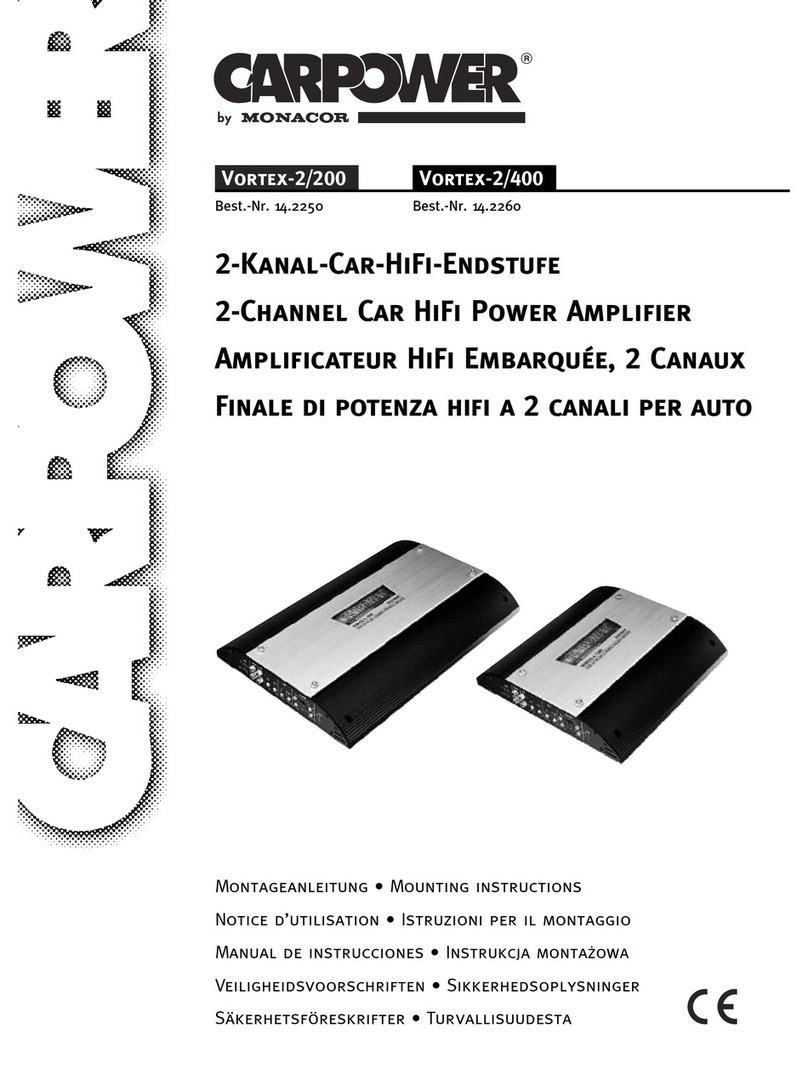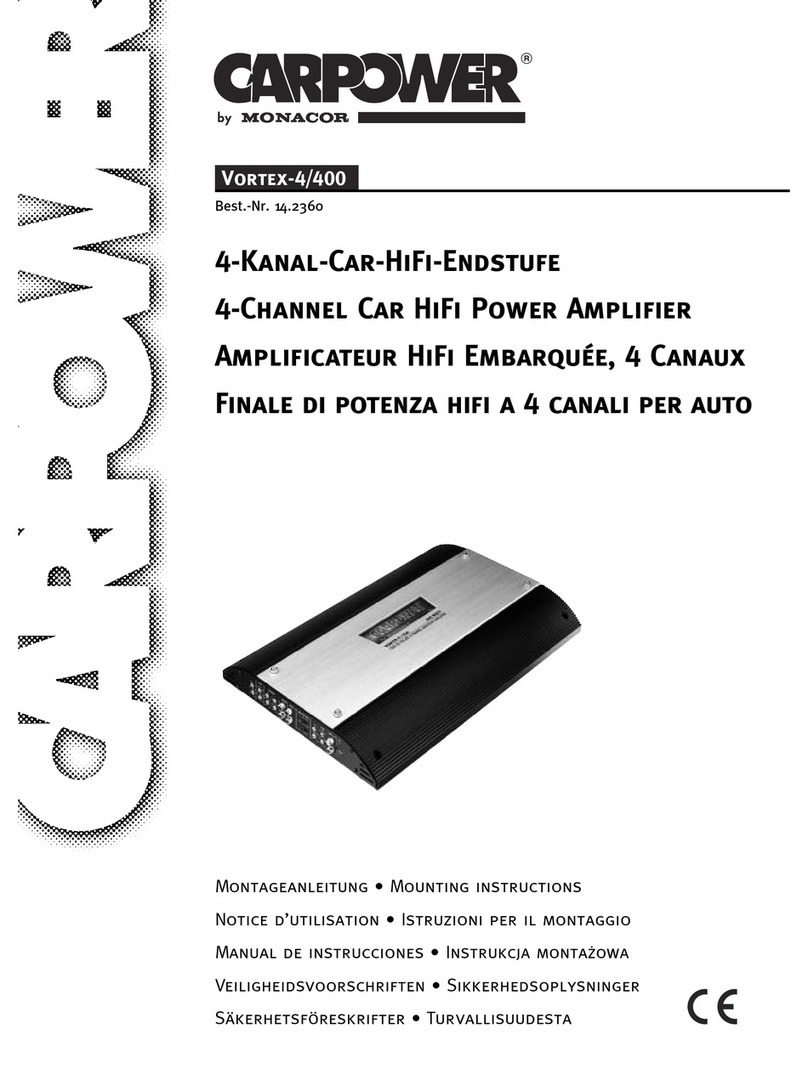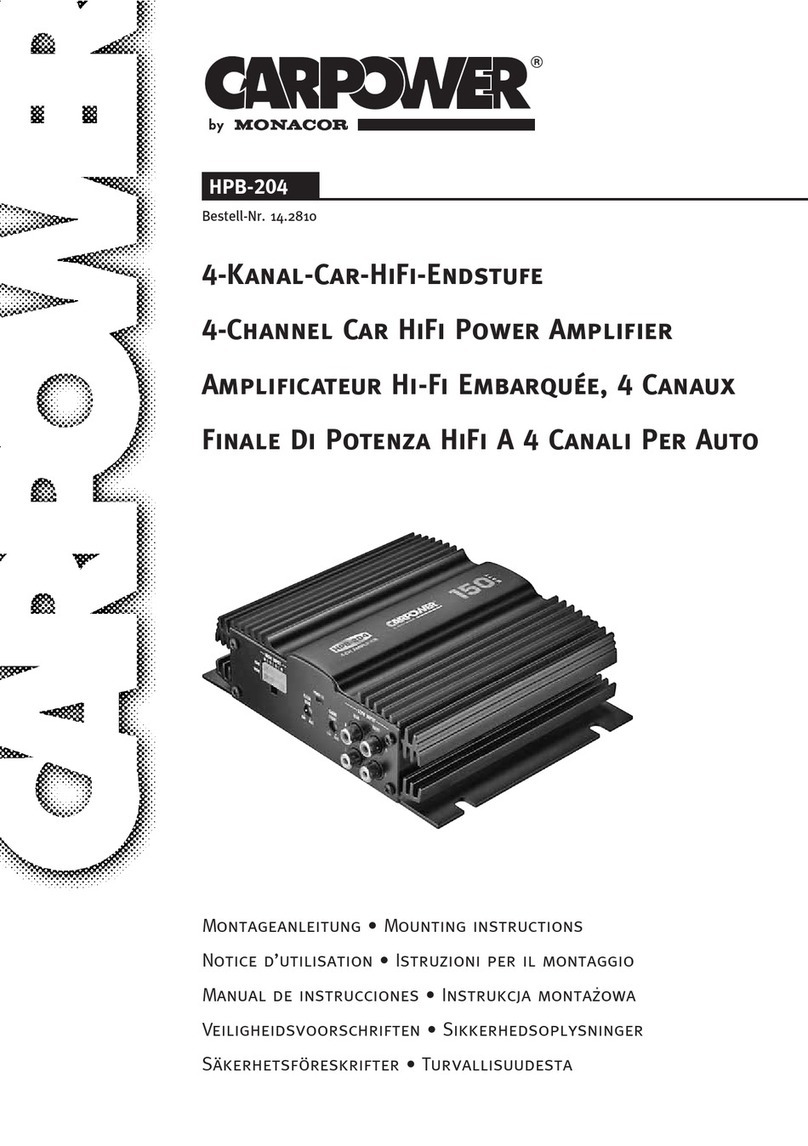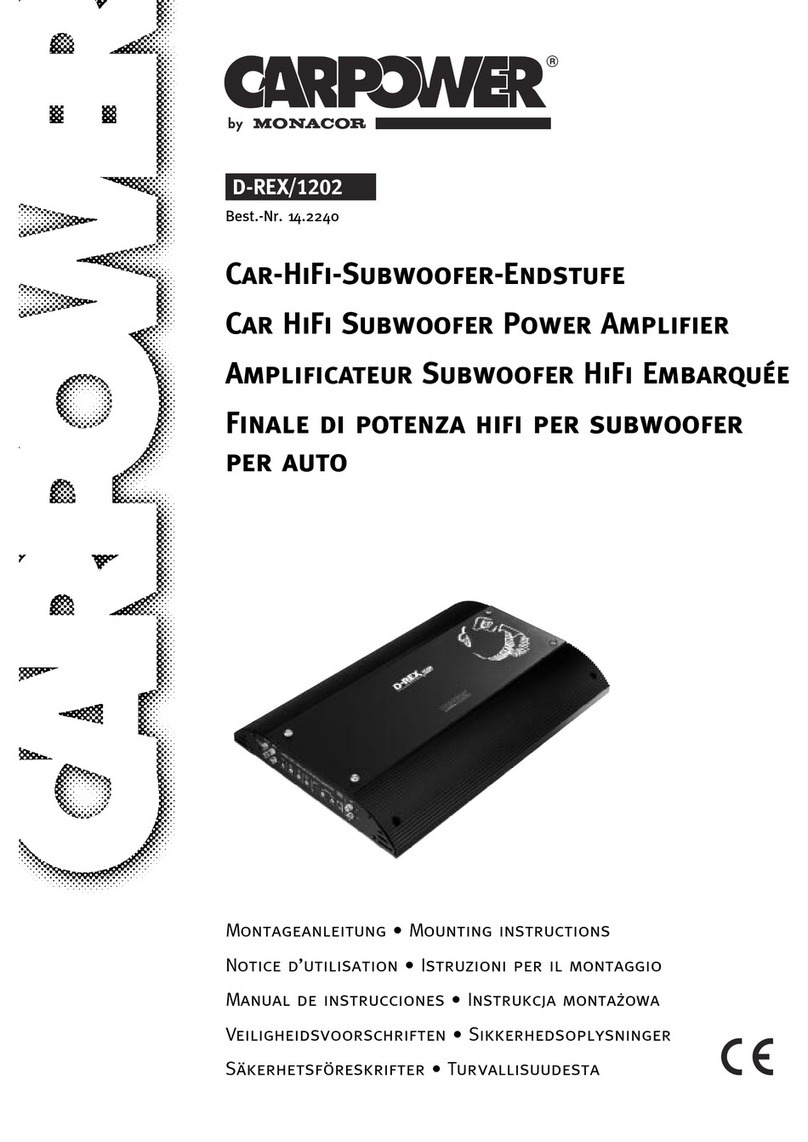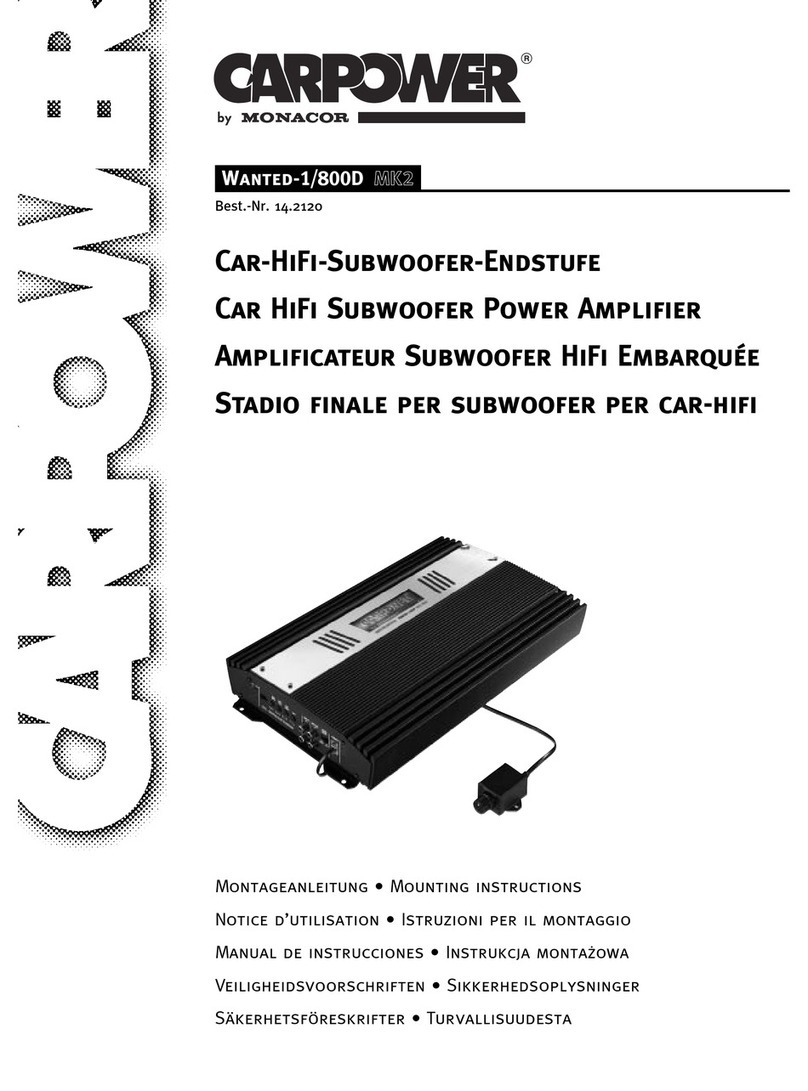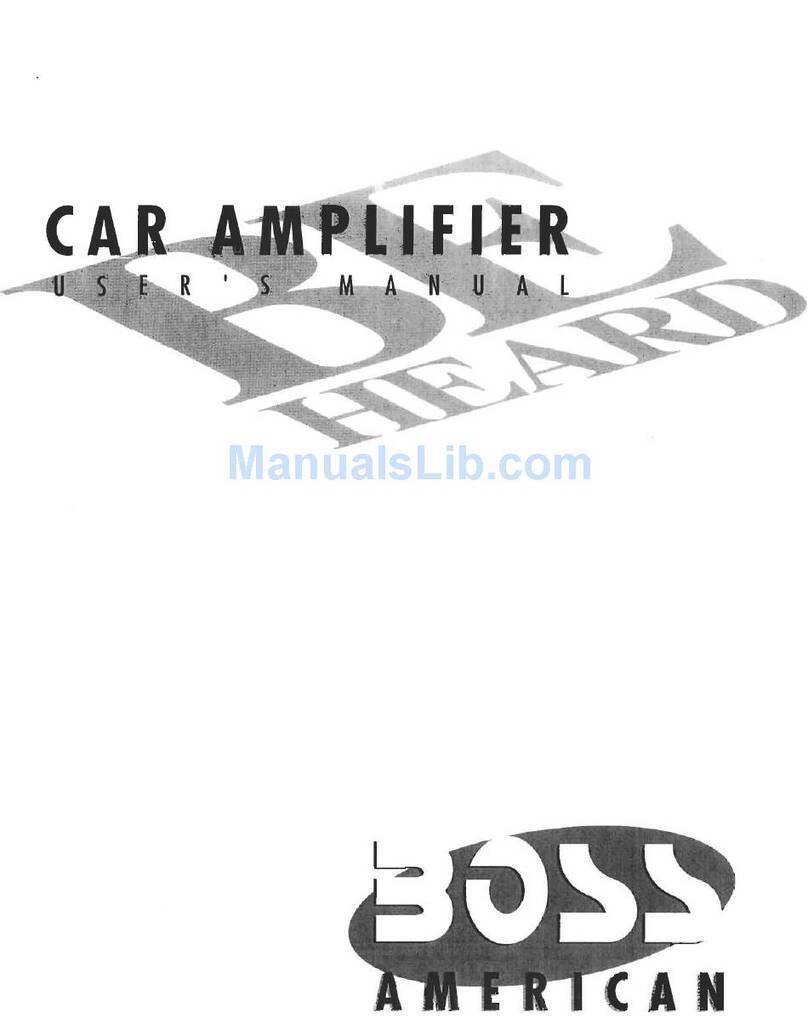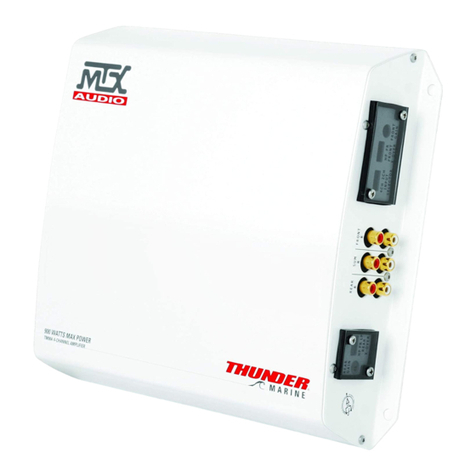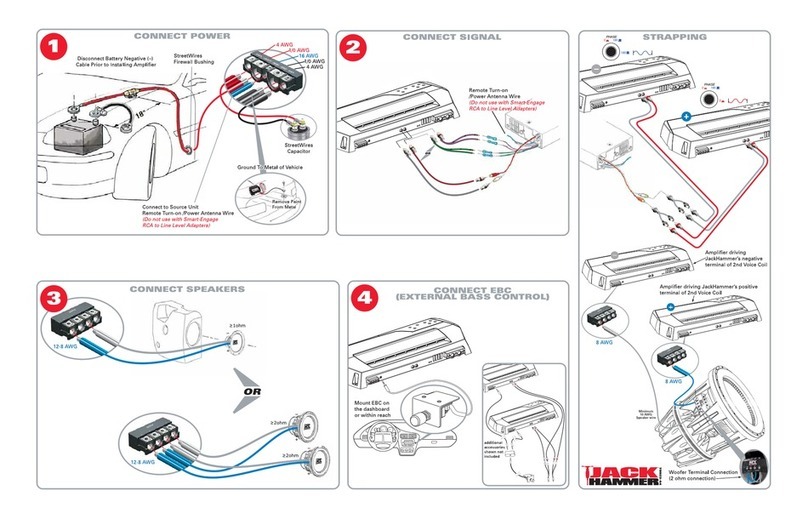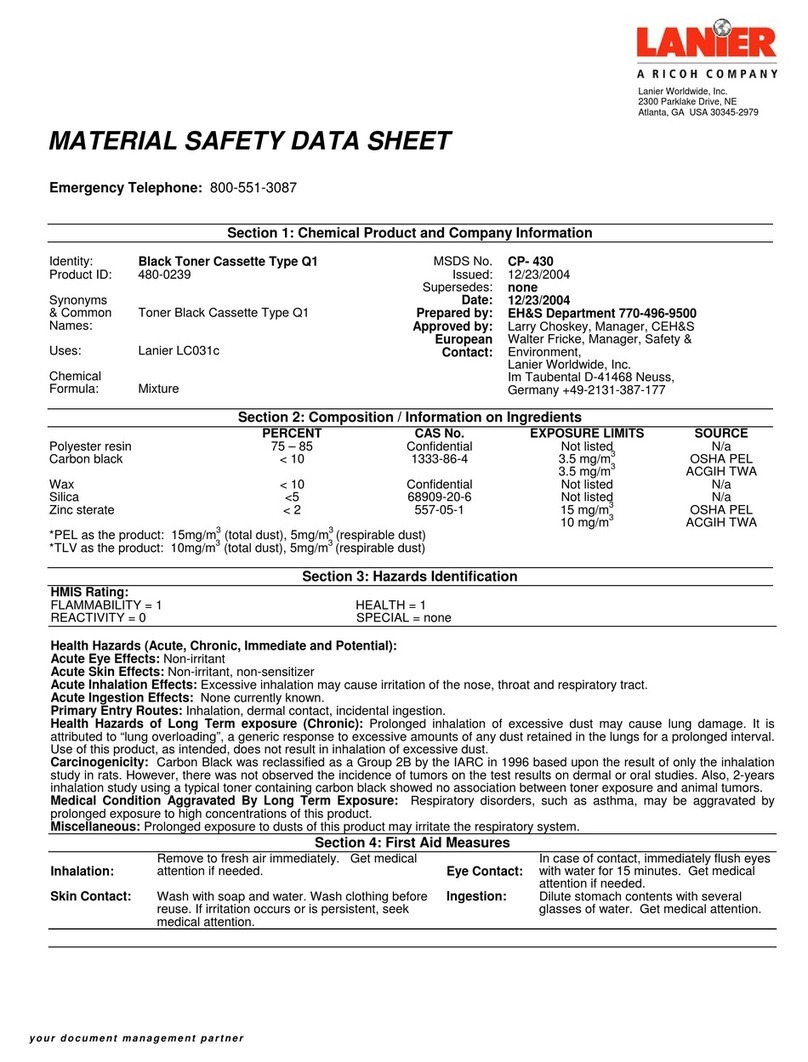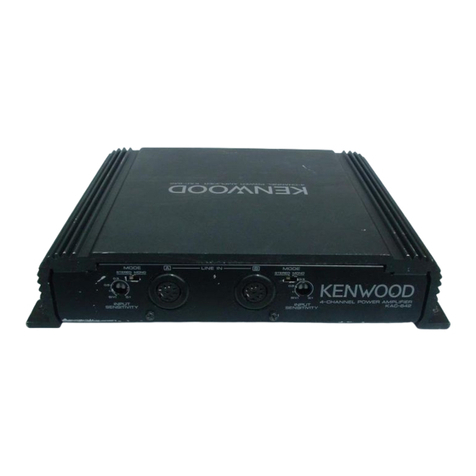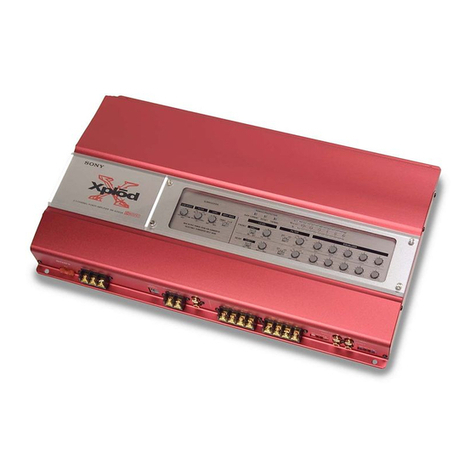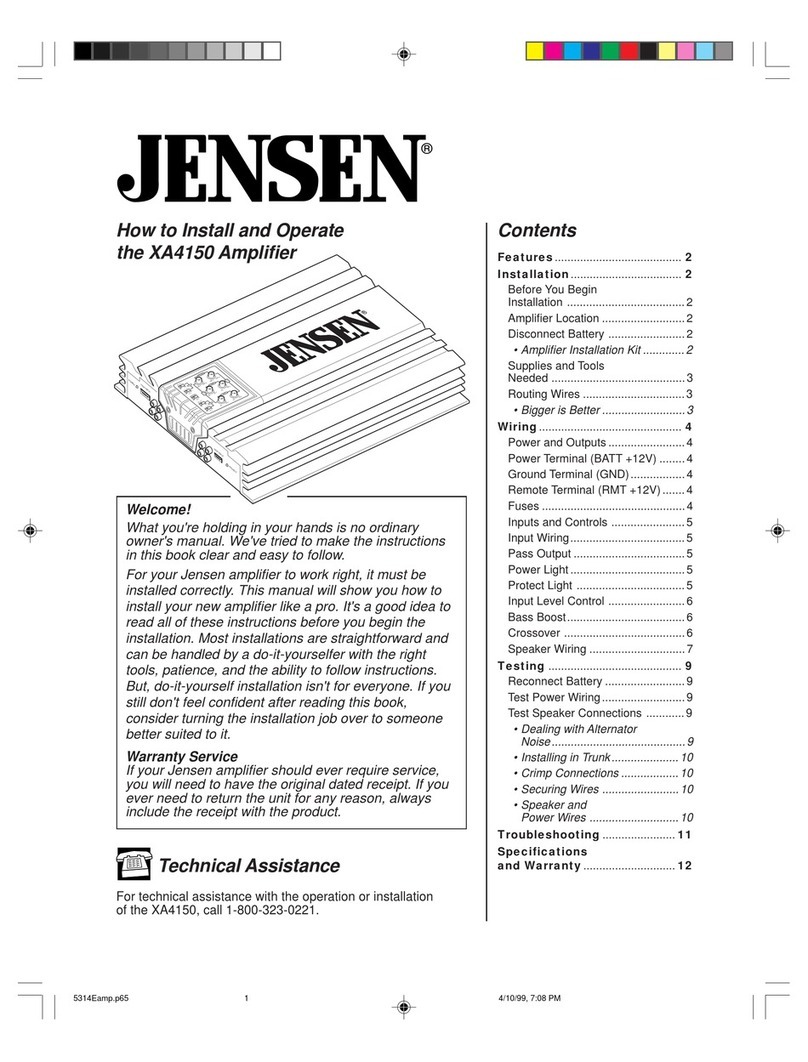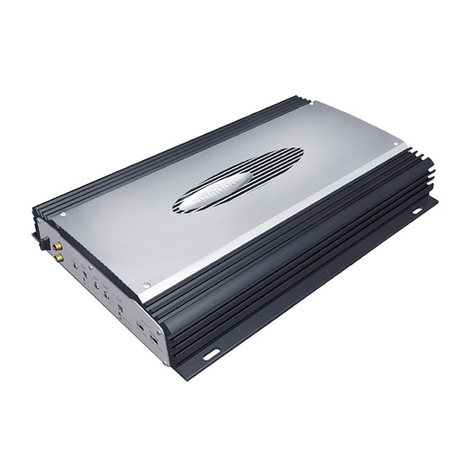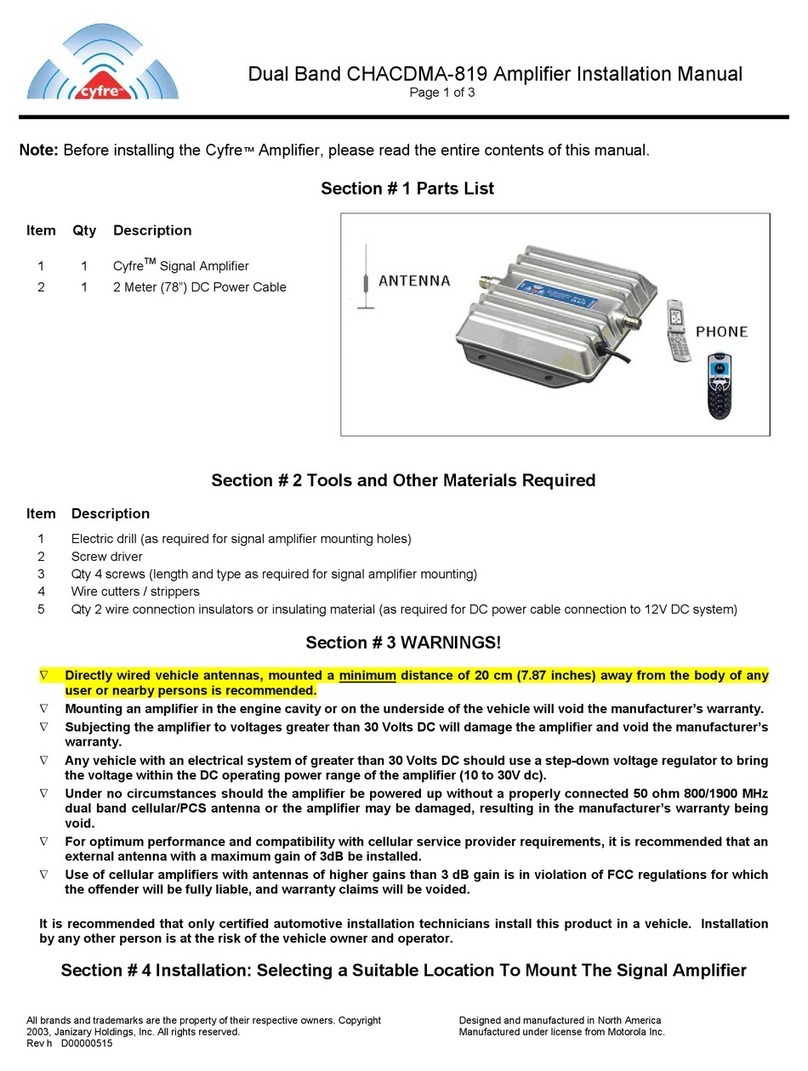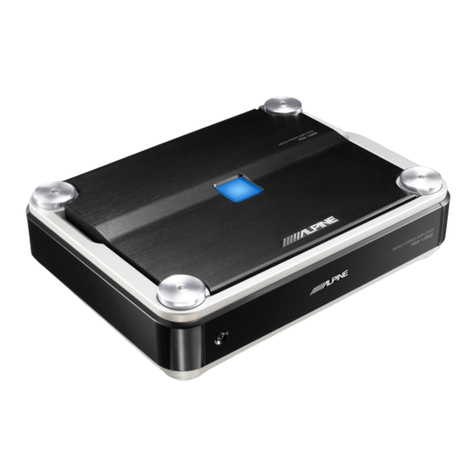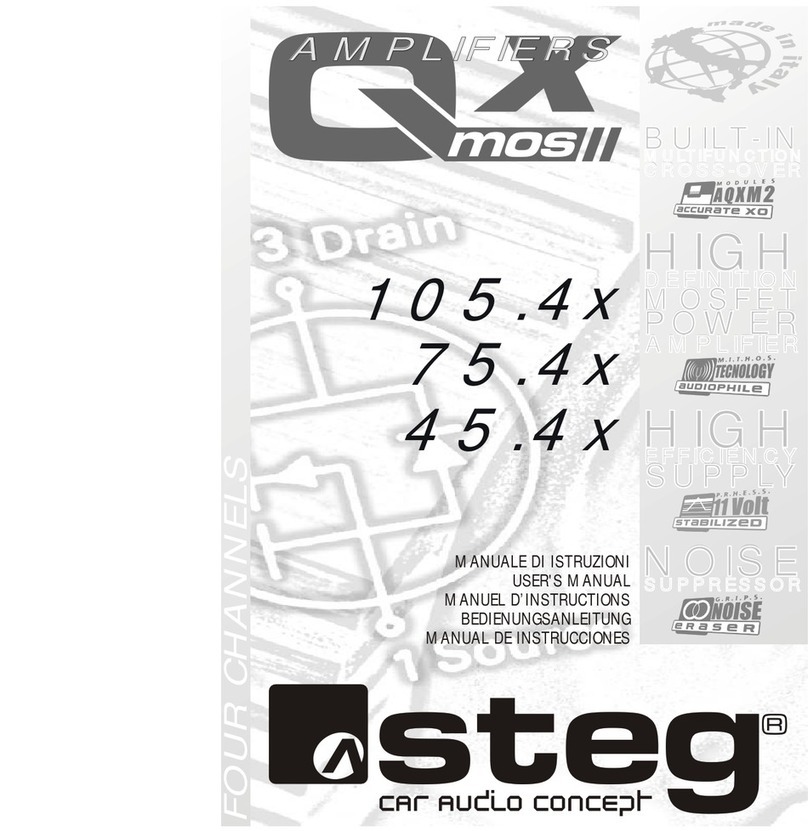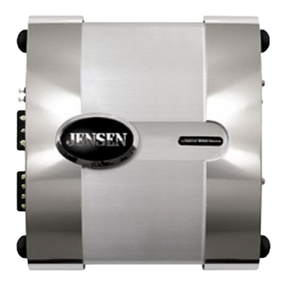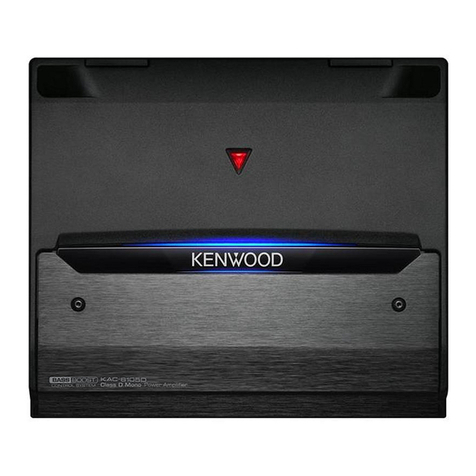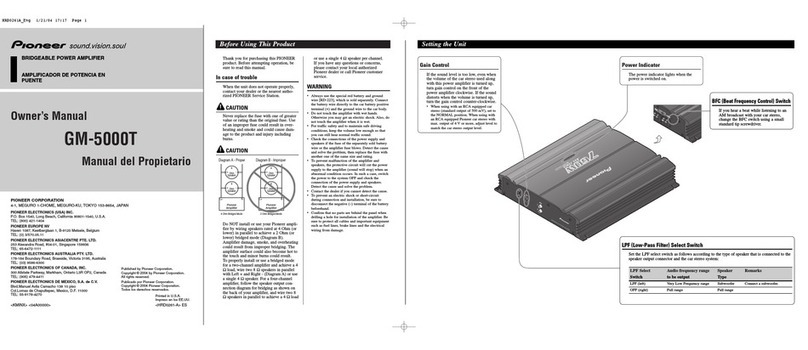sen (z. B. durch ausreichend viele Schweiß-
punkte). Eventueller Lack am Kontaktpunkt muss
vollständig entfernt werden.
2. Zur Vermeidung von Masseschleifen muss die
Masse des Autoradios an die Stelle gelegt wer-
den, an der auch die Endstufe an Masse liegt.
6.1.3 Steuerspannung zum Einschalten
Die Car-HiFi-Endstufe wird durch eine Steuerspan-
nung von +12 V am Anschluss REM (14) ein- und
ausgeschaltet. Den Anschluss REM mit dem 12-V-
Schaltausgang vom Autoradio verbinden (An-
schluss für eine Motorantenne, eventuell mit der
Motorantenne parallel schalten).
6.2 Line-Eingänge
Die Endstufe wird über Cinch-Kabel mit den Line-
Ausgängen am Autoradio verbunden. Sind am Auto-
radio jedoch keine Line-Ausgänge vorhanden, kön-
nen die Lautsprecherausgänge des Autoradios über
einen entsprechenden Übertrager (z. B. FGA-20*)
mit den Line-Eingängen der Endstufe verbunden
werden. Der genaue Anschluss richtet sich nach der
gewünschten Betriebsart der Endstufe:
6.2.1 4-Kanalbetrieb (Abb. 3)
Die Ausgänge des Autoradios mit den Eingängen
LINE IN (12) der folgenden Kanäle verbinden:
Front Links auf Kanal 1
Front Rechts auf Kanal 2
Rear Links auf Kanal 3
Rear Rechts auf Kanal 4
Sind am Autoradio keine Ausgänge für die hinteren
Kanäle (Rear) vorhanden, den Ausgang des linken
Kanals über ein Y-Kabel (z. B. CBA-25/SW*) mit
den Eingängen der Kanäle 1 und 3 verbinden und
den Ausgang des rechten Kanals über ein weiteres
Y-Kabel mit den Kanälen 2 und 4.
6.2.2 Brückenbetrieb (Abb. 4)
Den Ausgang des linken Kanals am Autoradio über
ein Y-Kabel (z. B. CBA-25/SW*) mit den Eingängen
LINE IN (12) der Kanäle 1 und 2 verbinden und den
Ausgang des rechten Kanals über ein weiteres
Y-Kabel mit den Kanälen 3 und 4.
6.2.3 Aktives 2-Wege-System (Bi-Amping) Abb. 6
Zum Aufbau eines aktiven 2-Wege-Systems den
Ausgang des linken Kanals am Autoradio mit dem
Eingang LINE IN (12) des Kanals 1 verbinden und
den Ausgang des rechten Kanals mit dem Eingang
des Kanals 2. Die Taste MODE (5) der Kanäle 3 und
4 nicht drücken und die Taste MODE (8) der Kanäle
1 und 2 drücken. Das Eingangssignal der Kanäle 1
und 2 wird dadurch auch auf die Kanäle 3 und 4
geschaltet, so dass keine zusätzlichen externen
Verbindungen hergestellt werden müssen.
Bei der Realisierung eines aktiven Kickbasses
beide Tasten MODE drücken. In diesem Fall die
Buchsen LINE OUT (11) und die Eingangsbuchsen
der Kanäle 3 und 4 über ein kurzes Cinch-Kabel ver-
binden und den Schiebeschalter MODE (10) ganz
nach rechts in die Position LOW stellen.
6.3 Line-Ausgänge
Wird für die Car-HiFi-Anlage ein weiterer Verstärker
benötigt, können dessen Eingänge an die Aus-
gangsbuchsen LINE OUT (11) angeschlossen wer-
den. Das benötigte Ausgangssignal mit dem Schie-
beschalter MODE (10) auswählen:
3/4 das Eingangssignal der Kanäle 3 und 4 liegt
an, jedoch durch die mit dem Regler HP (6)
eingestellten Hochpässe gefiltert [unabhän-
gig von der Stellung des Schalters MODE (5)]
1/2 das Eingangssignal der Kanäle 1 und 2 liegt
an, jedoch durch die mit dem Regler HP (9)
eingestellten Hochpässe gefiltert [unabhän-
gig von der Stellung des Schalters MODE (8)]
LOW das Eingangssignal der Kanäle 1/3 (L) und
2/4 (R) liegt an, jedoch durch die mit dem
Regler LP (3) eingestellten Tiefpässe gefiltert
[unabhängig von der Stellung der Schalter
MODE (5 und 8)]
Der erste Verstärker kann z. B. für vier Kanäle die
Mittelhochtöner antreiben und liefert die Bässe an
seinen Line-Ausgängen (Schiebeschalter MODE
auf LOW) für den weiteren Verstärker, der die Bass-
lautsprecher bzw. einenSubwoofer antreibt.
6.4 Lautsprecher
Der genaue Anschluss der Lautsprecher richtet sich
nach der gewünschten Betriebsart der Endstufe:
6.4.1 4-Kanalbetrieb
Die größte Ausgangsleistung wird beim Anschluss
von 2-Ω-Lautsprechern oder einer Lautsprecher-
gruppe mit einer Gesamtimpedanz von 2 Ωpro
Kanal erreicht (z. B. zwei 4-Ω-Lautsprecher parallel
geschaltet). Es können jedoch auch einzelne 4-Ω-
Lautsprecher angeschlossen werden, wobei sich
die Ausgangsleistung verringert. Die Lautsprecher
an die Klemmen SPEAKER (17) anschließen –
siehe auch Abb. 3:
CH 1+2 L+ = Pluspol Lautsprecher links vorne
CH 1+2 L
-
= Minuspol Lautsprecher links vorne
CH 1+2 R+ = Pluspol Lautsprecher rechts vorne
CH 1+2 R
-
= Minuspol Lautsprecher rechts vorne
CH 3+4 L+ = Pluspol Lautsprecher links hinten
CH 3+4 L
-
= Minuspol Lautsprecher links hinten
CH 3+4 R+ = Pluspol Lautsprecher rechts hinten
CH 3+4 R
-
= Minuspol Lautsprecher rechts hinten
Wichtig!
Alle Lautsprecher müssen 2-polig angeschlossen
werden, d. h. ohne gemeinsamen Masseanschluss.
Bei der Auswahl geeigneter Lautsprecher unbe-
dingt deren mechanische und elektrische Belast-
barkeit im Zusammenhang mit der genutzten End-
stufenleistung berücksichtigen (siehe auch tech-
nische Daten der Endstufe auf Seite 8).
2. To avoid ground loops, the ground of the car
radio must be applied at the place where also the
power amplifier is grounded.
6.1.3 Control voltage for switching-on
The car HiFi power amplifier is switched on and off
by a control voltage of +12 V at the terminal REM
(14). Connect the terminal REM to the 12 V control
output of the car radio (connection for a motor
antenna, if necessary, to be connected in parallel to
the motor antenna).
6.2 Line inputs
The power amplifier is connected via cables with
phono connectors to the line outputs at the car radio.
However, if no line outputs are provided at the car
radio, the speaker outputs of the car radio can be
connected via a corresponding transformer (e. g.
FGA-20*) to the line inputs of the power amplifier.
The exact connection depends on the desired op-
erating mode of the power amplifier:
6.2.1 4-channel operation (fig. 3)
Connect the outputs of the car radio to the inputs
LINE IN (12) of the following channels:
front left to channel 1
front right to channel 2
rear left to channel 3
rear right to channel 4
If no outputs for the rear channels are provided at
the car radio, connect the output of the left channel
via a Y cable (e.g. CBA-25/SW*) to the inputs of
channels 1 and 3 and the output of the right channel
via another Y cable to channels 2 and 4.
6.2.2. Bridge operation (fig. 4)
Connect the output of the left channel at the car
radio via a Y cable (e.g. CBA-25/SW*) to the inputs
LINE IN (12) of channels 1 and 2 and the output of
the right channel via another Y cable to channels 3
and 4.
6.2.3 Active 2-way system (bi-amping), fig. 6
To build up an active 2-way system, connect the out-
put of the left channel at the car radio to the input
LINE IN (12) of channel 1 and the output of the right
channel to the input of channel 2. Do not press the
button MODE (5) of channels 3 and 4 and press the
button MODE (8) of channels 1 and 2. Thus, the
input signal of channels 1 and 2 is also switched to
channels 3 and 4 so that no additional external
connections have to be made.
When realizing an active kick bass, however,
press the two buttons MODE. In this case connect
the jacks LINE OUT (11) and the input jacks of chan-
nels 3 and 4 via a short cable with phono connec-
tors, and set the sliding switch MODE (10) to the
right stop to position LOW.
6.3 Line outputs
If another amplifier is required for the car HiFi
system, its inputs can be connected to the output
jacks LINE OUT (11). Select the required output sig-
nal with the sliding switch MODE (10):
3/4 the input signal of channels 3 and 4 is pres-
ent, however, filtered through the high passes
adjusted with the control HP (6) [independ-
ent of the position of switch MODE (5)]
1/2 the input signal of channels 1 and 2 is pres-
ent, however, filtered through the high passes
adjusted with the control HP (9) [independ-
ent of the position of switch MODE (8)]
LOW the input signal of channels 1/3 (L) and 2/4
(R) is present, however, filtered through the
low passes adjusted with the control LP (3)
[independent of the position of switches
MODE (5 and 8)]
The first amplifier can e. g. drive the mid-high range
speakers for four channels and supplies the bass
frequencies to its line outputs (sliding switch MODE
to LOW) for the further amplifier which drives the
bass speakers or a subwoofer.
6.4 Speakers
The exact connection of the speakers depends on
the desired operation mode of the power amplifier:
6.4.1 4-channel operation
The greatest output power is reached when connect-
ing 2 Ωspeakers or a speaker group with a total
impedance of 2 Ωper channel (e. g. two 4 Ωspeak-
ers connected in parallel). However, it is also possi-
ble to connect individual 4 Ωspeakers, in which case
the output power is reduced. Connect the speakers
to the terminals SPEAKER (17) – also see fig. 3:
CH 1+2 L+ = positive pole speaker left front
CH 1+2 L
-
= negative pole speaker left front
CH 1+2 R+ = positive pole speaker right front
CH 1+2 R
-
= negative pole speaker right front
CH 3+4 L+ = positive pole speaker left rear
CH 3+4 L
-
= negative pole speaker left rear
CH 3+4 R+ = positive pole speaker right rear
CH 3+4 R
-
= negative pole speaker right rear
6.4.2 Bridge operation
In bridge operation the impedance of the connected
speakers or the total impedance of a speaker group
per bridged channel pair must not be lower than 4 Ω!
Connect the speakers to the terminals SPEAKER
(17) and pay attention to the lettering BRIDGE –
also see fig. 4:
CH 1+2 L+ = positive pole left speaker
CH 1+2 L
-
= remains unconnected
CH 1+2 R+ = remains unconnected
CH 1+2 R
-
= negative pole left speaker
Important!
All speakers must be connected with two poles,
i. e. without common ground connection. When
choosing suitable speakers, pay in any case atten-
tion to their mechanical and electrical capability in
connection with the amplifier power applied (also
see specifications of the amplifier page 8).
6
GB
D
A
CH
*von CARPOWER
*by CARPOWER

